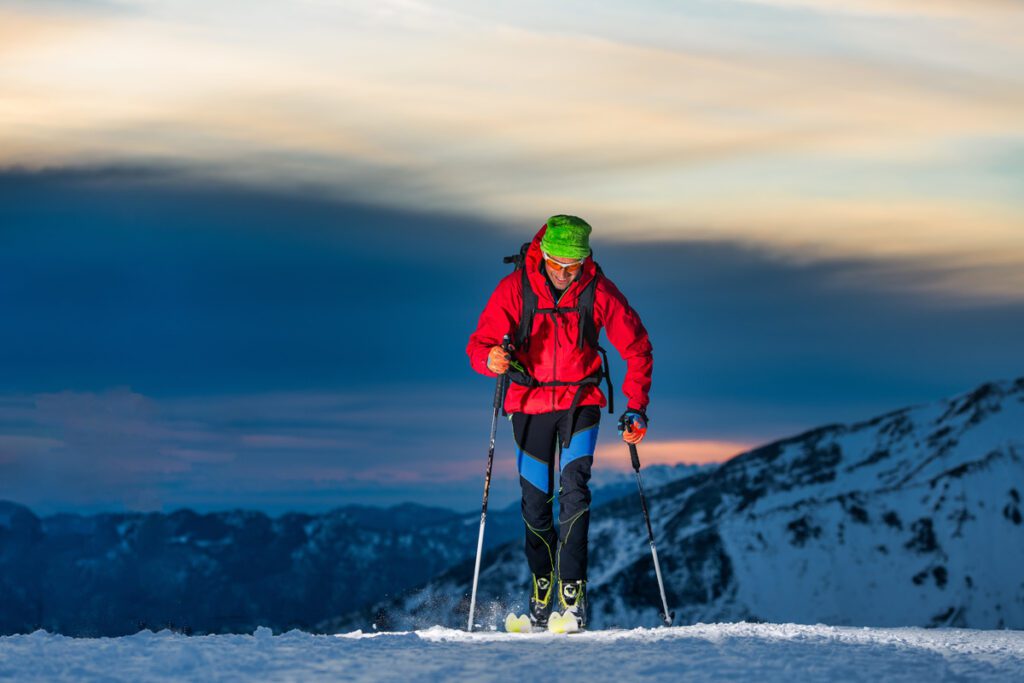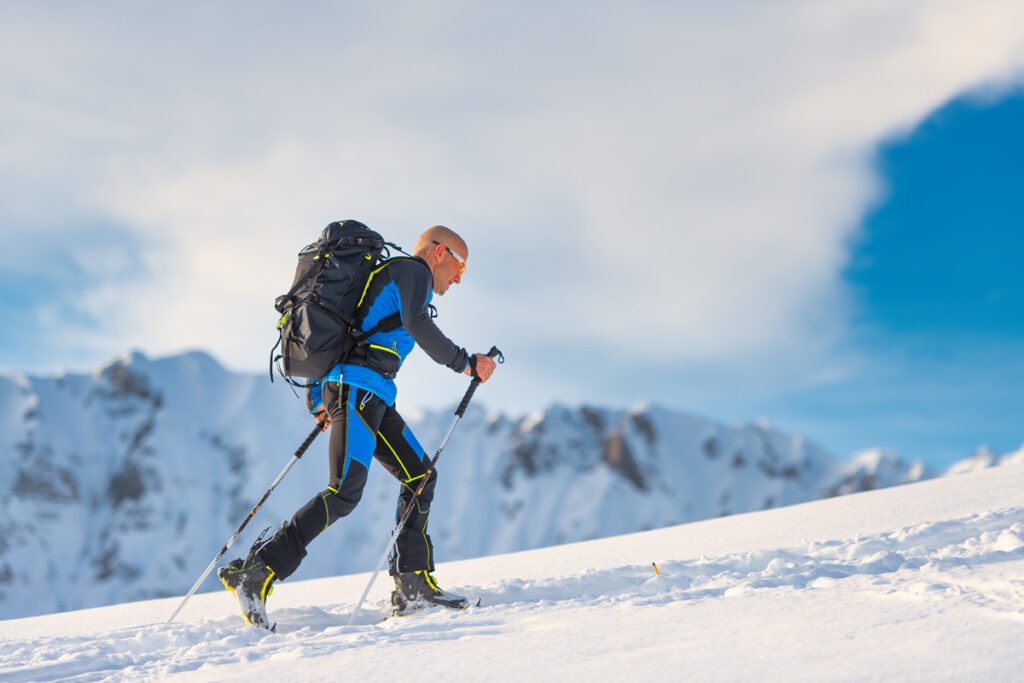Uphill Touring is on the Uptick
Uphill touring – also known as skinning, or alpine touring – has been around for decades but has gained popularity in more recent years for a variety of reasons. First, it’s amazing exercise. Next, you’re not reliant on a chair lift, tow rope or gondola to reach the summit because you do that part yourself. Third, it opens a whole new world of terrain to explore. Lastly, it puts you in total control to create a new adventure each time up (and down) the hill.

What is Skinning?
Skinning is the act of skiing up a mountain, hence “uphill touring”. To do this, you first need special bindings on your skis. These binding are different from normal bindings because the heal releases and the toe portion pivots so your foot can move up and down like you’re hiking – just with skis on your feet.
Attached to the bottom of your skis are “skins,” a strip of material that makes it possible for your skis to grip the snow as you climb the hill. Skins are usually made with a nylon blend or mohair on one side to grip the snow and are sticky on the other side to attach to your skis.
A good set of skins won’t fall off easily. They are made to stay on your skis through strenuous conditions but can be easily removed and stored when you’re ready to ski down.
Where Do You Go Skinning?
Skinning is done in the backcountry. Backcountry skiing is skiing in areas that are unmarked or unpatrolled. You won’t find groomed trails that are clearly marked – backcountry trails are you versus nature. Awesome backcountry adventures often require Snowcat or helicopter services to reach the best parts.
What Kind of Gear Do You Need for Uphill Touring?
If you plan on skinning, you’ll first need a set of skis or a snowboard that handles well in the backcountry. Just about any ski will work for backcountry skiing, but the best ones are usually lightweight so there is less strain getting up the hill. Most skiers prefer a lightweight model that’s a bit fatter, so it performs well during the ride down.
A favorite among snowboarders is a splitboard that separate down the middle of the board so it’s easier to move up the hill. There are also bindings that fit your regular boots and others that require specific ski boots. If you’re not using a splitboard, you’ll probably need snowshoes to make the hike.
As we mentioned earlier, you’ll need alpine touring bindings – sometimes referred to as AT bindings. There are several brands that make these special bindings, and they can range in price from affordable basic models to higher-end versions that are super light and versatile. There are two types of AT bindings: frame and tech. Frame bindings work with any ski boot and tech bindings require a specific boot.
You’ll also need skins to attach to the bottom of your skis or board to grip the snow. Most of today’s skins are attached to skis or a splitboard with a loop on the toe and an adhesive that sticks to the base. There’s also a clip on the tail. Keep in mind that synthetic skins usually grip better than mohair skins. But mohair skins that are made from Angora goat hair are known to slide better.

Important Notes About Backcountry Outings
First, never head to the backcountry alone. Since the terrain is unmarked and unpatrolled, it’s best to ski in a small group. Some ski resorts in North America have backcountry territory that’s technically at the resort but is unpatrolled, so you need to play it safe and follow all the rules.
On that note, most major ski resorts offer backcountry training so you can prepare and educate yourself before you head out. Backcountry skiing can be hard core and no joke! You’ll receive valuable avalanche training and learn why it’s important to pack your safety gear like avalanche beacons, avalanche probe, collapsible shovel and ice axe – just in case. There are many levels of classes so you can continue to step up your game and conquer the challenging backcountry elements.
Can I Rent Uphill Touring Gear?
Yes – it’s easy to rent alpine touring gear at many of the local ski shops where you already get your downhill gear. Renting skinning gear is the affordable way to go! Several ski rental shops offer a variety of rental options from top brands, and there are lots of backcountry adventures just waiting for you at North America’s top resorts. From Whistler to Aspen to Stowe, the finest ski resorts have epic backcountry experiences that you can book.
Is Skinning Fun for Kids?
Before you head out to the backcountry with your children, there are a few things to consider. First, skinning is physically demanding and it’s actually more difficult for people that are lighter weight. Therefore, it’s best to start with a flatter surface more like cross-country skiing to build muscle before attempting uphill touring.
To many, skinning is something special to share with loved ones. Keep in mind that Nordic skiing through a flat meadow or along the beautiful path can be just as rewarding as heading uphill. Physically fit teens and older children can really begin to enjoy skinning with parents once they’ve reached a more adult age and can handle the rigors.
When Should I Go Skinning?
Skinning is a fun activity any time of day. Over the years, it has become a favorite in the early mornings. There’s nothing quite like a sunrise skin up the mountain, or even a skin up in the twilight and sunrise ski down. It’s awesome exercise and a picture-perfect way to start your day. If you plan on skinning that early in the morning, make sure you pick up your rental gear the day before so you’re ready to go!
Is Alpine Touring Really That Fun?
If you head straight up the mountain, you’ll get tired too quickly because it’s too steep and exhausting. Skinning is more of a side-to-side, zig-zag movement up the hill, like the way you ski down the mountain. If you just pointed ‘em straight, you’d reach terminal velocity in no time. The same principal applies with skinning – it’s all about enjoying the journey. Skinning is a sport that is physically demanding but provides a beautiful peacefulness and interaction with nature.